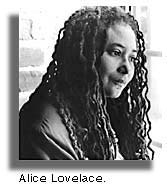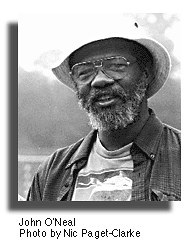|
(from Aristotle to Brecht, Baraka, O'Neal, and Boal) by Alice Lovelace Atlanta, Georgia  The following is taken from a longer article by Alice Lovelace. The entire article is called A Mutual Alliance: Mediation and Theater of the Oppressed in a Process for Social Change. This article extract begins to chronicle the development of modern theater, it's relationship to the audience and to the community, and how that relates to social change. Richard Southern (1961) defines art as a form of communications. This dialogue opens, "an address to the people." Southern divides the history of theater forms into the pre-Christian era (pagan or aboriginal myth) and the Christian era. In pre-European Christianity communities such as the Arawaks, Celtic, and some West African and Asiatic cultures, magic was in the religion which was the theater. Western European Christianity removed the magic from religion and invested it in their theater. The two periods could also be characterized as the age of the people's theater and the age of people in the theater. In the aboriginal theater, the community (artists were always a part of the community) gathered in the open, under the sky, nature providing the scenery and backdrop. The action was interdisciplinary, using mask, songs, dance, ritual, and unscripted so that the audience/community was free to intervene and shape it to their needs. This theater was under the authority of the community. Together they told their stories reflecting their values and world view. In the age of Christian theater forms, the actor became the focus. The community's role was reduced to listener/respondent. The drama moved indoors, onto a stage, raised above the audience/community, under artificial lights. With this form of theater came the introduction of words as the focus of attention. The communication was transformed, from that which had symbolic meaning and was open to interpretation, to the tightly defined and specific in meaning. Language became a barrier, turning the dialogue into a monologue (Southern 1961). Aristotle's observations on the structure and purpose of theater were built from Greek tragedy and even though some were later modified, many of his ideas were codified into iron-clad rules of theater (see discussion in Karl H. Schoeps, 1977) Aristotle raised the lives and values of the ruling class and the church to the objects of great theater. Good now had a particular kind of face, and morality could be identified with a certain way of life. He conceived of a theater to carry the world view and moral values of those in power, investing their language and symbols with authority and acceptance. Leaving the masses (parties to the conflict) to take on the passive role of audience. Later, the middle class emerged and a new character was created. This character was, like them, the exceptional individual, and the cult of the hero was born (see discussion in Boal, 1979). To be a hero one need only be a member of the ruling class or aristocracy, with a streak of independence. According to the precepts of Aristotle's tragedy, the hero is rewarded for upholding the values of his class, but in the end his flaw of character is punished severely, because this flaw was responsible for his rise to hero status. The people watch and through the emotions of pity and grief, suffer with him. The Evolution of Theater of the Oppressed In the opinion of Schoeps (1977) no one individual played a more important and fundamental role in the modern history of the theater forms than Bertolt Brecht (1896-1956). Brecht proved to be a major influence in the modern theater and offered a challenge to Aristotle's approach to theater as a spectator activity. Although he agreed with Aristotle that the theater should be, "a place of fun and pleasure", he did not want to "wring the pleasure" from his audience by draining them emotionally. Brecht vigorously objected to the Aristotelian concept of catharsis (see footnotes), seeking instead to stimulate the minds of his audience concerning the world around them, their status in that world and the conflicts that were playing out around them. Brecht desired for the audience to respond with intellect not emotion. Schoeps considers Brecht "an original," capable of adapting literary heritage for his own purpose, and successful at integrating economics and politics into his text. For Schoeps, Brecht's contribution to theater is best illustrated in The Caucasian Chalk Circle a play in which the singer/narrator acts as storyteller, commentator and interpreter of the conflict. (See footnotes) A character that demonstrates elements of a talented intervenor. In the United States, some of Brecht most noted followers include The Living Theater Collective, organized in 1947 under the leadership of actors Judith Malina and Julian Beck. Since the 1950s his influence has grown and inspired such groups as the San Francisco Mime Troupe, and El Teatro Campesino. Brecht's influence is also evident in the works of widely read activist, Imamu Amiri Baraka (formerly LeRoi Jones). In 1964, Baraka politicized the national stage with The Dutchman, that won an Obie Award, followed in 1965 with The Slave and The Toilet. Baraka's plays symbolize the confrontation, hostility, and mistrust between blacks and whites in America (Schoeps 1977). Brecht's effect was felt all across the nation, even at the grassroots level. He influenced activist artists like John O'Neal, an African-American writer, and actor known for his character portrayal of the folk character, June Bug Jubba Jones. O'Neal, credits the effect of Brecht and The Living Theater for his decision to create theater that speaks to the dignity and grace of African Americans in the face of overt oppression.
Brecht's most remarkable and innovative student to date is Augusto Boal, a Brazilian political activist and artistic director of the Arena Theater from 1956-1971. In 1979 Boal published Theater of the Oppressed, a book that chronicles his development as a cultural worker, and in which he responds to the influence of Brecht and education theorist Paulo Freire on his thinking. Paulo Freire (1970) asked that artists show their support of the people's struggle by giving themselves over to the thinking of the people. He did not encourage focusing on the actions of man, such a focus causes confusion, but rather focus on "the thought-language with which men refer to reality, the levels at which they perceive that reality, and their view of the world." Do not go to the people with the objective to bring them salvation, he cautions, but rather to understand through dialogue, "Their objective situation and their awareness of that situation." Boal took this charge to heart, combined his activist calling with his theater experience and created a form of theater that proved useful to Brazil's underclass's effort to transform their personal and social reality into political awareness and action. Boal looked to theater as an instrument of education, rejecting the popular idea of theater as only spectacle and entertainment. His objective was to increase the capacity to confront internal and external factors in deeply rooted conflict by increasing the capacity to conceive of change. With the production of ZUMI, the Arena Theater's most successful production, came the creation of The Joker, Boal's innovative contribution to community theater committed to social change. The Joker allows the audience to see the conflict from many angles, to contemplate why a conflict occurred and what could conceivably happen next. Boal (1979) believes these goals are reached through a theater form operating, "within the transitoriness of theatrical techniques." His seven stage approach includes: dedication, explanation, episode, scenes, commentary, interview and exhortation.
One of Boal's most popular techniques to help parties visualize the conflict is Image Theater. Image Theater was inspired by Japanese filmmaker Akira Kurosawa's study in multiple perception. This technique deals with, "how we come to create the Other: a negatively-charged rigid perception that generates bias and hate." Image Theater provides a tool to challenge stereotypes and promote empathy. Other Theater of the Oppressed techniques include analytical image, kaleidoscopic image, screen image, image and counter image, image of the antagonists, cop-in-the-head, and the rainbow of desire. (See footnotes) Like Brecht, Boal (1979) stands in functional agreement with but political antithesis to Aristotle. He agrees that theater should function in the life of the receiver, resonating their values and aspirations. Boal rejects Aristotle when he declares art independent in relation to politics. Theater for Aristotle was one of the controls to teach and reinforce the inferior role of those deemed unequal. Boal interprets Aristotle's message as, "happiness consists in obeying the laws." Thus, he believes, Aristotle actually constructs a powerful political system, "for intimidation of the spectator for elimination of the bad or illegal tendencies of the audience." Also see: Index of articles and poetry by Alice Lovelace |
| Published in In Motion Magazine - February 15, 1996. |
If you have any thoughts on this or would like to contribute to an ongoing discussion in the  What is New? || Affirmative Action || Art Changes || Autonomy: Chiapas - California || Community Images || Education Rights || E-mail, Opinions and Discussion || En español || Essays from Ireland || Global Eyes || Healthcare || Human Rights/Civil Rights || Piri Thomas || Photo of the Week || QA: Interviews || Region || Rural America || Search || Donate || To be notified of new articles || Survey || In Motion Magazine's Store || In Motion Magazine Staff || In Unity Book of Photos || Links Around The World NPC Productions Copyright © 1995-2020 NPC Productions as a compilation. All Rights Reserved. |


 Using Brecht as a major reference for his writing and thinking, and the Suitcase Theater of Langston Hughes and Ted Ward as his model, O'Neal along with Tom Dent and Gilbert Moss, founded The Free Southern Theater (1963) in New Orleans. The goal was to make theater that encouraged and supported those in the movement. This theater would place on stage the life of poor and working class people in the south, promoting critical and reflective thought among those working in the Civil Rights Movement. Free Southern Theater's motto was, "Theater for those who have no theater," (J. O'Neal, personal communication, December 18, 1995).
Using Brecht as a major reference for his writing and thinking, and the Suitcase Theater of Langston Hughes and Ted Ward as his model, O'Neal along with Tom Dent and Gilbert Moss, founded The Free Southern Theater (1963) in New Orleans. The goal was to make theater that encouraged and supported those in the movement. This theater would place on stage the life of poor and working class people in the south, promoting critical and reflective thought among those working in the Civil Rights Movement. Free Southern Theater's motto was, "Theater for those who have no theater," (J. O'Neal, personal communication, December 18, 1995).